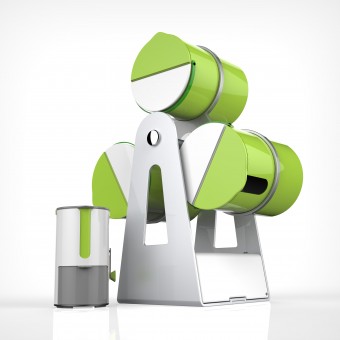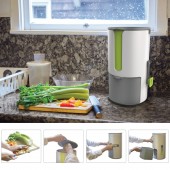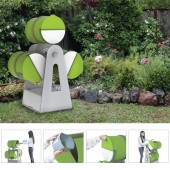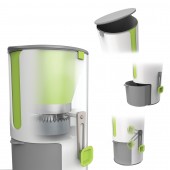Green Project - Home Composting System Home Composting System by Han Gao & On Yu Wu |
Home > Winners > #36517 |
 |
|
||||
| DESIGN DETAILS | |||||
| DESIGN NAME: Green Project - Home Composting System PRIMARY FUNCTION: Home Composting System INSPIRATION: The designers were inspired by Rodgers Ranch Urban Farm and Teaching Gardens. The designers were motivated to create a pleasing experience for home composting and attract more Bay Area participants. UNIQUE PROPERTIES / PROJECT DESCRIPTION: Green Project aims to create efficient human-powered products and appealing designs for home composting. Green Project provides a Kitchen Grinder for solving the difficult problem of preparing food waste and a three-bin Backyard Composter to speed up the process. The latter features a rotating design that increases airflow, creating an optimal compost environment. It also has a water tank base for stability and convenience when adding moisture to the compost. OPERATION / FLOW / INTERACTION: First, open the Kitchen Grinder lid and put the food waste inside, then rotate the handle to grind the waste into suitable-sized pieces. Next, one would take the drawer out from the Kitchen Grinder and take it to the Backyard Composter to deposit the food waste into the selected compost bin. Finally, one would move the retaining pin on the rotating bracket. This allows the entire mechanism to spin on the rod, thereby turning and aerating the compost. Lastly, replace the pin, locking the bracket into place until the next use. PROJECT DURATION AND LOCATION: Green project started in February 2014 and finished in May 2014 at California College of the Arts. It was later presented at the Rodgers Ranch Urban Farm and Teaching Gardens in Pleasant Hill, California. FITS BEST INTO CATEGORY: Social Design |
PRODUCTION / REALIZATION TECHNOLOGY: Kitchen Grinder: Extruded plastic body, CNC machined stainless steel grinder. Backyard Composter: Extruded plastic bins and water sink, die-cut metal frames and bracket. SPECIFICATIONS / TECHNICAL PROPERTIES: Kitchen Grinder: Diameter 8" x Height 12;" Composter Bin: Diameter 15" x Width 20;" Backyard Composter: Width 35" x Depth 22" x Height 35" TAGS: Sustainable, Eco-friendly, Compost, Social Design RESEARCH ABSTRACT: The designers collaborated with Rodgers Ranch Farm to gain knowledge about composting and collect user feedback regarding existing products. The designers experienced composting firsthand and interviewed experts to gain insights. It became apparent that smaller pieces of food waste decomposed faster than large, unground chunks. However, it is usually not efficient to chop food waste by hand. Secondly, the compost needed to be turned for proper aeration. However, it is extremely difficult to flip the compost even with the help of tools. CHALLENGE: The hardest part of this project was not only to create efficient human-powered products, but also to make the design appealing and interesting. The designers were challenged to work together as well, in order to create consistent design language for the two products. ADDED DATE: 2014-09-19 18:00:22 TEAM MEMBERS (2) : Han Gao and On Yu Wu IMAGE CREDITS: Image #2, #3: Photographer Sharon Peng, 2014. |
||||
| Visit the following page to learn more: http://www.rihango-design.com/greenproje |
|||||
| AWARD DETAILS | |
 |
Green Project-Home Composting System Home Composting System by Han Gao & On Yu Wu is Winner in Social Design Category, 2014 - 2015.· Read the interview with designer Han Gao & On Yu Wu for design Green Project - Home Composting System here.· Press Members: Login or Register to request an exclusive interview with Han Gao & On Yu Wu. · Click here to register inorder to view the profile and other works by Han Gao & On Yu Wu. |
| SOCIAL |
| + Add to Likes / Favorites | Send to My Email | Comment | Testimonials | View Press-Release | Press Kit |
Did you like Han Gao & On Yu Wu's Social Design?
You will most likely enjoy other award winning social design as well.
Click here to view more Award Winning Social Design.








